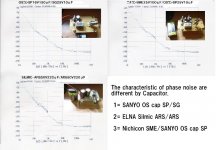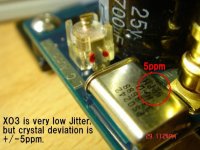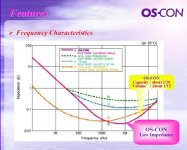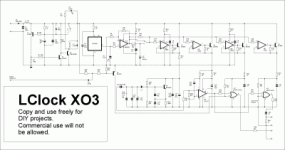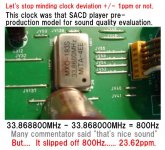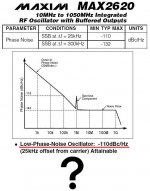YOKOHAMA Tire co.,ltd
Hello Extreme_Boky,
YOKOHAMA Tire Co.,LTD headquarters place TOKYO.
This is my car tire, that YOKOHAMA DNA S-Drive 225/45,245/45/R18
http://minkara.carview.co.jp/userid/284478/car/177954/946266/parts.aspx
http://minkara.carview.co.jp/userid/284478/car/177954/profile.aspx
Hello Extreme_Boky,
YOKOHAMA Tire Co.,LTD headquarters place TOKYO.
This is my car tire, that YOKOHAMA DNA S-Drive 225/45,245/45/R18
http://minkara.carview.co.jp/userid/284478/car/177954/946266/parts.aspx
http://minkara.carview.co.jp/userid/284478/car/177954/profile.aspx
OSCON's are good, aren't they...
They can feed the noise from Vcc to the ground (common) plane, and they do excellent job.
Now, please consider what will happen if you lower the noise OF THE COMMON (GROUND PLANE) and you keep the OSCONS?
This is why I recommended to ground the oscillator to the SACD PCB ground plane with the least amount of noise.
Regards,
Boky
They can feed the noise from Vcc to the ground (common) plane, and they do excellent job.
Now, please consider what will happen if you lower the noise OF THE COMMON (GROUND PLANE) and you keep the OSCONS?
This is why I recommended to ground the oscillator to the SACD PCB ground plane with the least amount of noise.
Regards,
Boky
Re: YOKOHAMA Tire co.,ltd
Beautiful car with very nice tires...
Cheers,
Boky
nagaesan said:Hello Extreme_Boky,
YOKOHAMA Tire Co.,LTD headquarters place TOKYO.
This is my car tire, that YOKOHAMA DNA S-Drive 225/45,245/45/R18
http://minkara.carview.co.jp/userid/284478/car/177954/946266/parts.aspx
http://minkara.carview.co.jp/userid/284478/car/177954/profile.aspx
Beautiful car with very nice tires...
Cheers,
Boky
OS cap Low ESR
SANYO OS-CON is very low ESR and good frequency characteristics.
http://www.edc.sanyo.com/english/pr...n/download.html
SANYO OS-CON is very low ESR and good frequency characteristics.
http://www.edc.sanyo.com/english/pr...n/download.html
Attachments
Re: XO3 is good C/N but +/-5ppm deviation
parts per million deviation is not that important; the important thing to know (or measure if you have the equipment that can do it) is jitter performance at around 10Hz.
5 PPM means that you will either LOOSE or GAIN for example 5 seconds in approximately 11 days' period (Wikipedia), and this is not important for us at all - AS LONG AS THOSE seconds "keep coming" at exactly the same intervals.
Boky
nagaesan said:Let's stop minding clock deviation +/- 1ppm or not.
parts per million deviation is not that important; the important thing to know (or measure if you have the equipment that can do it) is jitter performance at around 10Hz.
5 PPM means that you will either LOOSE or GAIN for example 5 seconds in approximately 11 days' period (Wikipedia), and this is not important for us at all - AS LONG AS THOSE seconds "keep coming" at exactly the same intervals.
Boky
This is XO3 schematic
Let's refer to low JITTER good C/N clock schamatic.
(It is different my original clock unit)
http://www.lcaudio.com/images/LClock/xo3dias.gif
Let's refer to low JITTER good C/N clock schamatic.
(It is different my original clock unit)
http://www.lcaudio.com/images/LClock/xo3dias.gif
Attachments
Yes, the amount of jitter at around 10Hz will directly affect the timing of our clock signal, and our ears are very sensitive (actually, our brain!) to these variations.
The lower the power supply noise - the lower the jitter - hence - lower disturbance and more accurate timing of our clock signal.
Some prefer sine wave output, some square wave... it is academic...but I am sure many would discuss this topic to the Nth degree.
Boky
The lower the power supply noise - the lower the jitter - hence - lower disturbance and more accurate timing of our clock signal.
Some prefer sine wave output, some square wave... it is academic...but I am sure many would discuss this topic to the Nth degree.
Boky
Let's stop minding clock deviation +/- 1ppm or not.
This is pre-production model for commentator & reputator sound check.
SACD decorder module frequency is 33.868800MHz.
But this was 33.868000MHz clock.
Because, even if 800Hz (23.62ppm) slipped, people did not notice it.
This is pre-production model for commentator & reputator sound check.
SACD decorder module frequency is 33.868800MHz.
But this was 33.868000MHz clock.
Because, even if 800Hz (23.62ppm) slipped, people did not notice it.
Attachments
EXACTLY!
as long as "whatever quantity of MHz remains" ARRIVES AT THE EXACT SAME RATE everything's sweet!
Boky,
as long as "whatever quantity of MHz remains" ARRIVES AT THE EXACT SAME RATE everything's sweet!
Boky,
Re: Jitter = phase Noise
MAX2620 is better.
nagaesan said:Dear oscillator researchers
clock deviation ..... +/-1ppm, = not jitter
clock purity.............C/N, phase noise,-130dBc@100Hz = Jitter
I measured several crystal oscillator's Phase Noise with hp E5501B.
Attached file is LcAudio XO-3 jitter.
It is very nice jiter than usual SPXO and TCXO oscillators.
Crystal oscillator produces undesirable phase noise near the output frequency.
�@Phase noise is measured in the frequency domain, and is expressed as a ratio of signal power to noise power measured in a 1 Hz,10Hz,100Hz,1000Hz, bandwidth at a given offset from the desired signal.
MAX2620 is better.
Do you have graphs like the ones in this thread for the DEXA D-clock?
http://www.newclassd.com/index.php?page=20
http://www.newclassd.com/index.php?page=20
I have oscillators in my DACs marked:
TCXO-230
xxx MHz
SCTF 03
So they are from Shenzhen SCTF Electronics.
I cannot find a meaning for the -230 ending but the sheet I can find for DIP-14 TCXO starts at -70 dB jitter at 10 Hz. 1.5-2 ppm over time.
10Hz 100Hz 1kHz 10kHz 100kHz
-70 -95 -120 -145 -150 dBc/Hz
Could be better?
What is the meaning of the -230?
Are better noise spec oscillators available? If so: where?
Or do I need a `full` (expensive) clock?
What is the relation between the clocking of a transport and that of the DAC?
I.e.: does the DAC clock matter more or less than the transport clock?
TCXO-230
xxx MHz
SCTF 03
So they are from Shenzhen SCTF Electronics.
I cannot find a meaning for the -230 ending but the sheet I can find for DIP-14 TCXO starts at -70 dB jitter at 10 Hz. 1.5-2 ppm over time.
10Hz 100Hz 1kHz 10kHz 100kHz
-70 -95 -120 -145 -150 dBc/Hz
Could be better?
What is the meaning of the -230?
Are better noise spec oscillators available? If so: where?
Or do I need a `full` (expensive) clock?
What is the relation between the clocking of a transport and that of the DAC?
I.e.: does the DAC clock matter more or less than the transport clock?
Gents,
We at vacuum State have been doing some extreme jitter experiments on various clock designs, and have found that the powerssupply of the clock oscillator is VASTLY more important than anyone has ever realised.
The Chinese clock that started this thread proudly says it uses LM317's as regulators - well we found they are not quiet enough by a HUGE amount in our tests, and now have filtering beyond anything anyone would consider sane or reasonable, but the sound keeps getting better and better.
We now market two clocks using this technology, and there are success stories on our website from end users. The TerraFirma Lite is not cheap, but would be of interest to serious experimentors.
Regards, Allen (Vacuum State)
We at vacuum State have been doing some extreme jitter experiments on various clock designs, and have found that the powerssupply of the clock oscillator is VASTLY more important than anyone has ever realised.
The Chinese clock that started this thread proudly says it uses LM317's as regulators - well we found they are not quiet enough by a HUGE amount in our tests, and now have filtering beyond anything anyone would consider sane or reasonable, but the sound keeps getting better and better.
We now market two clocks using this technology, and there are success stories on our website from end users. The TerraFirma Lite is not cheap, but would be of interest to serious experimentors.
Regards, Allen (Vacuum State)
Allen Wright said:Gents,
We at vacuum State have been doing some extreme jitter experiments on various clock designs, and have found that the powerssupply of the clock oscillator is VASTLY more important than anyone has ever realised.
The Chinese clock that started this thread proudly says it uses LM317's as regulators - well we found they are not quiet enough by a HUGE amount in our tests, and now have filtering beyond anything anyone would consider sane or reasonable, but the sound keeps getting better and better.
We now market two clocks using this technology, and there are success stories on our website from end users. The TerraFirma Lite is not cheap, but would be of interest to serious experimentors.
Regards, Allen (Vacuum State)
As you are still using the Tent module it can't be better than that.
You supply looks primitive to my eyes.
🙁
Re: MAX2620 is better?
Page 6 of the datasheet shows SINGLE SIDEBAND PHASE NOISE 10dB lower than the LCaudio. And this is with a cermic resonator so I guess it will be much better with a good crystal.
nagaesan said:MAX2620 is better?
Page 6 of the datasheet shows SINGLE SIDEBAND PHASE NOISE 10dB lower than the LCaudio. And this is with a cermic resonator so I guess it will be much better with a good crystal.
Tico wrote:
>As you are still using the Tent module it can't be better than that<
Why not? The TENT with our powersupply is HUGELY improved over the TENT with other powersupplies. And even cheaper oscillators with our powersupply sound pretty much equal to the TENT.
>You supply looks primitive to my eyes.<
Primitive? You can tell circuit topology, circuit concepts and circuit values from looking at a photo? Opinions don't count for much with me. What do you like then?
Regards, Allen (Vacuum State)
>As you are still using the Tent module it can't be better than that<
Why not? The TENT with our powersupply is HUGELY improved over the TENT with other powersupplies. And even cheaper oscillators with our powersupply sound pretty much equal to the TENT.
>You supply looks primitive to my eyes.<
Primitive? You can tell circuit topology, circuit concepts and circuit values from looking at a photo? Opinions don't count for much with me. What do you like then?
Regards, Allen (Vacuum State)
Re: Re: MAX2620 is better?
Don't get too excited, the Offset frequency on that grapph, is KHz
not Hz away from carrier. 🙂
So we are talking -105dBc/Hz at 10KHz not 10Hz.
This is to be expected it is a cheap chip solution.
cheers
T
QSerraTico_Tico said:
Page 6 of the datasheet shows SINGLE SIDEBAND PHASE NOISE 10dB lower than the LCaudio. And this is with a cermic resonator so I guess it will be much better with a good crystal.
Don't get too excited, the Offset frequency on that grapph, is KHz
not Hz away from carrier. 🙂
So we are talking -105dBc/Hz at 10KHz not 10Hz.
This is to be expected it is a cheap chip solution.
cheers
T
- Status
- Not open for further replies.
- Home
- Source & Line
- Digital Line Level
- 16.9344MHz LOW JITTER CLOCK KIT...
